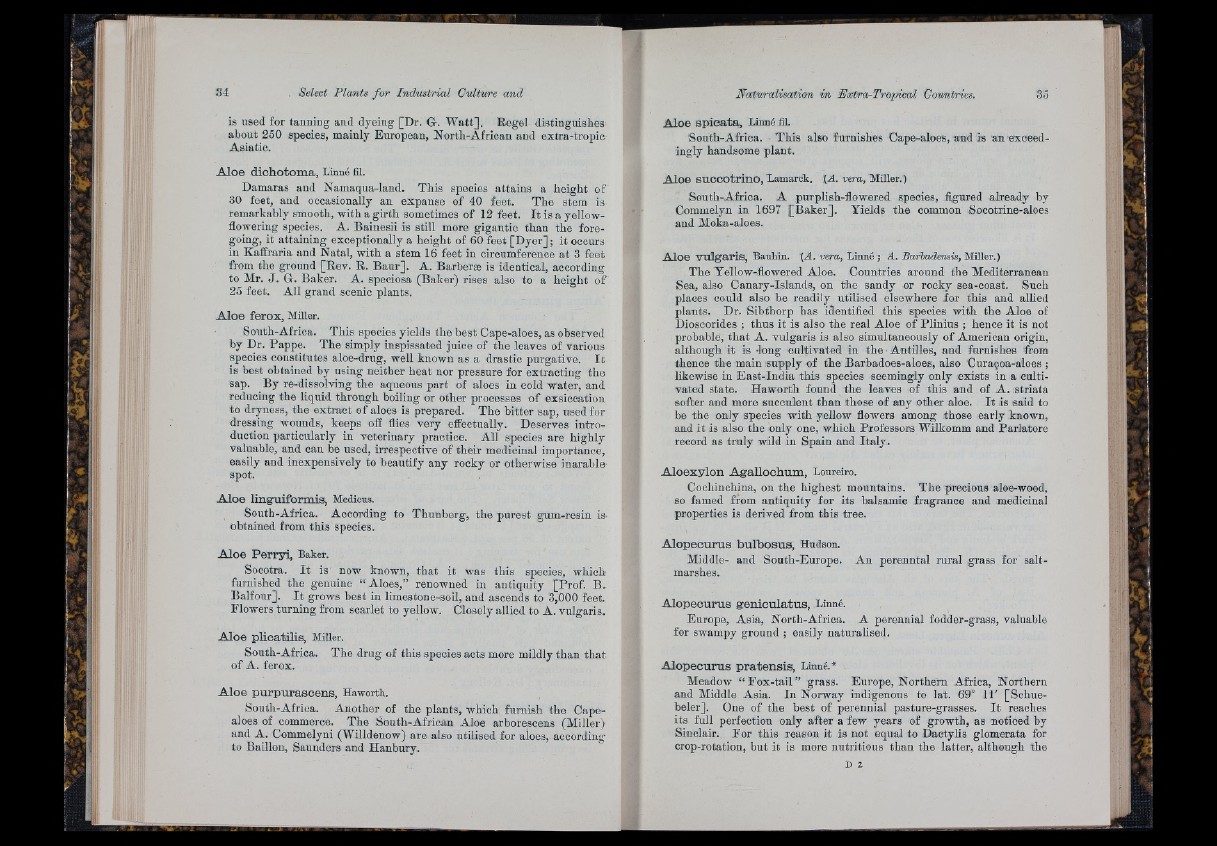
is used for taiiuiog and dyeing [Dr. G. W a tt], Regel distinguishes
about 250 species, mainly European, North-African and extra-tropic
Asiatic.
A lo e d ic h o tom a , Linné fil.
Damaras and Namaqua-land. This species attains a height of
30 feet, and occasionally an expanse of 40 feet. The stem is
remarkably smooth, with a girtk sometimes of 12 feet. I t is a yellow-
flowering species. A. Bainesii is still more gigantic than the foregoing,
it attaining exceptionally a height of 60 feet [Dyer] ; it occurs
in Kaffraria and Natal, with a stem 16 feet in circumference a t 3 feet
from the ground [Rev. R. Baur]. A. Barberæ is identical, according
to Mr. J . G. Baker. A. speciosa (Baker) rises also to a height of
25 feet. All grand scenic plants.
A lo e ferox, Miller.
South-Africa. This species yields the best Cape-aloes, as observed
by Dr. Pappe. The simply inspissated juice of the leaves of various
species constitutes aloe-drug, well known as a drastic purgative. I t
is best obtained by using neither heat nor pressure for extracting the
sap. By re-dissolving the aqueous part of aloes in cold water, and
reducing the liquid through boiling or other processes of exsiccation
to dryness, the extract of aloes is prepared. The bitter sap, used for
dressing wounds, keeps off flies very effectually. Deserves introduction
particularly in veterinary practice. All species are highly
valuable, and can be used, irrespective of their medicinal importance,
easily and inexpensively to beautify any rooky or otherwise inarable
spot.
A lo e lin g u ifo rm is, Medicus.
South-Africa. According to Thunberg, the purest gum-resin is
obtained from this species.
A lo e P e rry i, Baker.
Socotra. I t is now known, th a t it was
furnished the genuine “ Aloes,” renowned in
Balfour], I t grows best in limestone-soil, and ascends to S'OOO feet.
Flowers turning from scarlet to yellow. Closely allied to A. vulgaris.
this species, which
antiquity [Prof. B..
A lo e p lic a tilis, Miller.
South-Africa. The drug of this species acts more mildly than that
of A. ferox.
A lo e p u rp u r a s c e n s , Haworth.
South-Africa. Another of the plants, which furnish the Cape-
aloes of commerce. The South-African Aloe arborescens (Miller)
and A. Commelyni (Willdenow) are also utilised for aloes, according
to Bâillon, Saunders and Hanbury.
Alo e sp ic a ta , Linné fil.
South-Africa. This also furnishes Cape-aloes, and is an exceedingly
handsome plant.
Alo e s u c c o trin o , Lamarck. (A. vera, Miller.)
South-Africa. A purplish-flowered species, figured already by
Commelyn in 1697 [Baker],
and Moka-aloes.
Yields the common Socotrine-aloes
A lo e v u lg a ris , Bauhin. {A. vera, Linné; A. BarTtadensis, Miller.)
The Yellow-flowered Aloe. Countries around the Mediterranean
Sea, also Canary-Islands, on the sandy or rocky sea-coast. Such
places could also be readily utilised elsewhere for this and allied
plants. Dr. Sibthorp has identified this species with the Aloe of
Dioscorides ; thus it is also the real Aloe of Plinius ; hence it is not
probable, th a t A. vulgaris is also simultaneously of American origin,
although it is -long cultivated in the Antilles, and furnishes from
thence the main supply of the Barbadoes-aloes, also Curaçoa-aloes ;
likewise in East-India this species seemingly only exists in a cultivated
state. Haworth found the leaves of this and of A. striata
softer and more succulent than those of any other aloe. I t is said to
be the only species with yellow flowers among those early known,
and it is also the only one, which Professors Wilkomm and Parlatore
record as truly wild in Spain and Italy.
A lo e x y lo n A g a llo c h um , Loureiro.
Cochiuohina, on the highest mountains. The precious aloe-wood,
so famed from antiquity for its balsamic fragrance and medicinal
properties is derived from this tree.
-Alopecurus b u lb o s u s , Hudson.
Middle- aud South-Europe.
marshes.
An perenntal rural grass for salt-
A lo p e o u ru s g e n ic u la tu s , Linné.
Europe, Asia, North-Africa. A perennial fodder-grass, valuable
for swampy ground ; easily naturalised.
A lo p e c u ru s p ra te n s is , Linné.*
Meadow “ F o x -ta il” grass. Europe, Northern Africa, Northern
and Middle Asia. In Norway indigenous to lat. 69° 11' [Schue-
heler]. One of the best of perennial pasture-grasses, I t reaches
its full perfection only after a few years of growth, as noticed by
Sinclair. Por this reason it is not equal to Dactylis glomerata for
crop-rotation, but it is more nutritious than the latter, although the